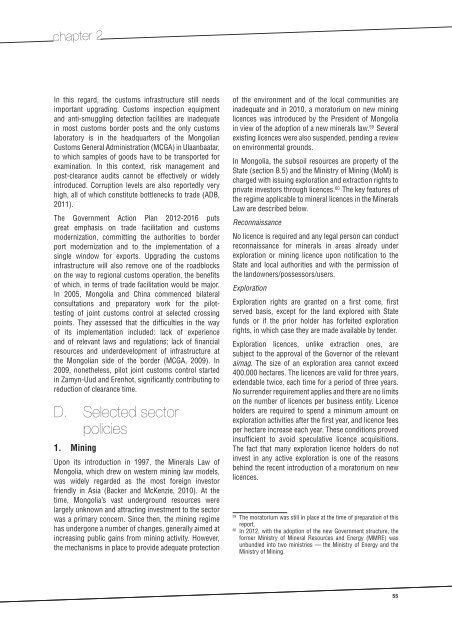UNCTAD-Mongolia
UNCTAD-Mongolia
UNCTAD-Mongolia
You also want an ePaper? Increase the reach of your titles
YUMPU automatically turns print PDFs into web optimized ePapers that Google loves.
chapter 2<br />
In this regard, the customs infrastructure still needs<br />
important upgrading. Customs inspection equipment<br />
and anti-smuggling detection facilities are inadequate<br />
in most customs border posts and the only customs<br />
laboratory is in the headquarters of the <strong>Mongolia</strong>n<br />
Customs General Administration (MCGA) in Ulaanbaatar,<br />
to which samples of goods have to be transported for<br />
examination. In this context, risk management and<br />
post-clearance audits cannot be effectively or widely<br />
introduced. Corruption levels are also reportedly very<br />
high, all of which constitute bottlenecks to trade (ADB,<br />
2011).<br />
The Government Action Plan 2012-2016 puts<br />
great emphasis on trade facilitation and customs<br />
modernization, committing the authorities to border<br />
port modernization and to the implementation of a<br />
single window for exports. Upgrading the customs<br />
infrastructure will also remove one of the roadblocks<br />
on the way to regional customs operation, the benefits<br />
of which, in terms of trade facilitation would be major.<br />
In 2005, <strong>Mongolia</strong> and China commenced bilateral<br />
consultations and preparatory work for the pilottesting<br />
of joint customs control at selected crossing<br />
points. They assessed that the difficulties in the way<br />
of its implementation included: lack of experience<br />
and of relevant laws and regulations; lack of financial<br />
resources and underdevelopment of infrastructure at<br />
the <strong>Mongolia</strong>n side of the border (MCGA, 2009). In<br />
2009, nonetheless, pilot joint customs control started<br />
in Zamyn-Uud and Erenhot, significantly contributing to<br />
reduction of clearance time.<br />
D. Selected sector<br />
policies<br />
1. Mining<br />
Upon its introduction in 1997, the Minerals Law of<br />
<strong>Mongolia</strong>, which drew on western mining law models,<br />
was widely regarded as the most foreign investor<br />
friendly in Asia (Backer and McKenzie, 2010). At the<br />
time, <strong>Mongolia</strong>’s vast underground resources were<br />
largely unknown and attracting investment to the sector<br />
was a primary concern. Since then, the mining regime<br />
has undergone a number of changes, generally aimed at<br />
increasing public gains from mining activity. However,<br />
the mechanisms in place to provide adequate protection<br />
of the environment and of the local communities are<br />
inadequate and in 2010, a moratorium on new mining<br />
licences was introduced by the President of <strong>Mongolia</strong><br />
in view of the adoption of a new minerals law. Several<br />
5929<br />
existing licences were also suspended, pending a review<br />
on environmental grounds.<br />
In <strong>Mongolia</strong>, the subsoil resources are property of the<br />
State (section B.5) and the Ministry of Mining (MoM) is<br />
charged with issuing exploration and extraction rights to<br />
private investors through licences. The key features of<br />
6030<br />
the regime applicable to mineral licences in the Minerals<br />
Law are described below.<br />
Reconnaissance<br />
No licence is required and any legal person can conduct<br />
reconnaissance for minerals in areas already under<br />
exploration or mining licence upon notification to the<br />
State and local authorities and with the permission of<br />
the landowners/possessors/users.<br />
Exploration<br />
Exploration rights are granted on a first come, first<br />
served basis, except for the land explored with State<br />
funds or if the prior holder has forfeited exploration<br />
rights, in which case they are made available by tender.<br />
Exploration licences, unlike extraction ones, are<br />
subject to the approval of the Governor of the relevant<br />
aimag. The size of an exploration area cannot exceed<br />
400,000 hectares. The licences are valid for three years,<br />
extendable twice, each time for a period of three years.<br />
No surrender requirement applies and there are no limits<br />
on the number of licences per business entity. Licence<br />
holders are required to spend a minimum amount on<br />
exploration activities after the first year, and licence fees<br />
per hectare increase each year. These conditions proved<br />
insufficient to avoid speculative licence acquisitions.<br />
The fact that many exploration licence holders do not<br />
invest in any active exploration is one of the reasons<br />
behind the recent introduction of a moratorium on new<br />
licences.<br />
59<br />
The moratorium was still in place at the time of preparation of this<br />
report.<br />
60<br />
In 2012, with the adoption of the new Government structure, the<br />
former Ministry of Mineral Resources and Energy (MMRE) was<br />
unbundled into two ministries — the Ministry of Energy and the<br />
Ministry of Mining.<br />
55




